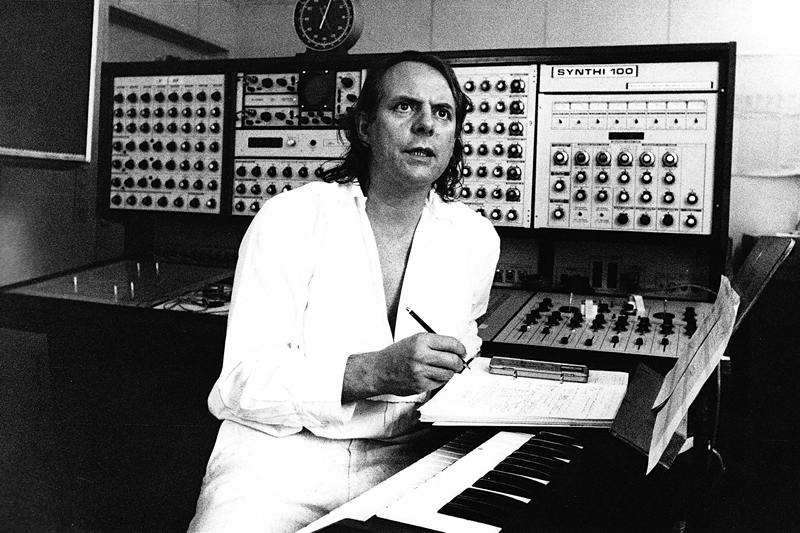
Instrumentation Works for Orchestra
Stockhausen Complete Edition on CD
Since 1991, a complete edition of all recordings in which Karlheinz Stockhausen has personally participated is being released on compact discs. Each CD in this series is identified by Stockhausen's signature followed by an encircled number. The numbers indicate the general historical order of the works.
Stockhausen realised the electronic music and participated in these recordings as conductor, performer, sound projectionist, and musical director. He personally mixed down the recordings, mastered them for CDs, wrote the texts and drew the covers.
- The compact discs may be obtained from the Stockhausen-Verlag: Kettenberg 15, 51515 Kuerten, Germany (www.stockhausenCDs.com).
Karlheinz Stockhausen
Instrumentation Works for Orchestra
MIXTUR 2003
Introduction
In 1964 I composed MIXTUR (MIXTURE) for orchestra, 4 sine-wave
generators and 4 ring modulators, work number 16. In 1967, I added a second
score entitled MIXTUR for small orchestra (work number 16½). Both were
published by Universal Edition in Vienna.
I took part in numerous performances as sound projectionist. During
this time, many changes and supplements became necessary, especially in
regard to dynamics, successions of pitches, timbres, sound equipment, performance
practice.
For many years, I had intended to write a new score in which all of
these experiences were taken into account. In 2003, I wrote this score, entitled
MIXTUR 2003 for orchestra (work number 16 2/3).
MIXTUR is the genesis of live electronic orchestra music and it has left
its imprint on the awareness of electronic sound transformation.
What concerns the ring modulation: In addition to the original analogue
equipment which was monitored by ear, with manual regulation of the sine
waves, I have also experienced performances using digital equipment and
programmed setting of the sine-wave frequencies and glissandi. Presently
(2003), I still prefer the "old" equipment. Especially when the frequencies
are set and changed, and the glissandi are performed by ear by good musicians
– interacting with the conductor – a unique quality results.
Concerning the sound mixture: The sound projectionist must regulate
a great deal by ear and must practice balancing the 5 groups during all
rehearsals. When regulating the general dynamic level, he can support the
envelope curves which result. To do this, a mixer with 8 VCA faders is very
useful. The overall sound should be full, spatially plastic. To accomplish
this, it is important that the front loudspeakers are not hung above the stage
apron, but rather further to the back, above the orchestra. The rear loudspeakers
should be spread apart as shown in the drawing on page XV.
The unmodulated and modulated orchestra sounds should be equally loud; the sound of the modulated orchestra should even be slightly louder. Especially the low ring modulation – which should be heard as rhythm – must be as strong as possible.
Instrumentation with 35 players Tuning: A = 440 Hz.
4 sine-wave generators: 4 players.
4 small mixers with 4 ring modulators : 4 sound mixers.
Suggestion for clothing (coloured shirts)
1st percussionist dark blue; 2nd percussionist orange; 3rd percussionist violet;
WOODWINDS bright blue (also sine-wave player and mixer);
ARCO strings yellow (also sine-wave player and mixer);
PIZZICATO strings bright green (also sine-wave player and mixer);
BRASS bright red (also sine-wave player and mixer);
conductor white or other; sound projectionist burgundy; technicians black.
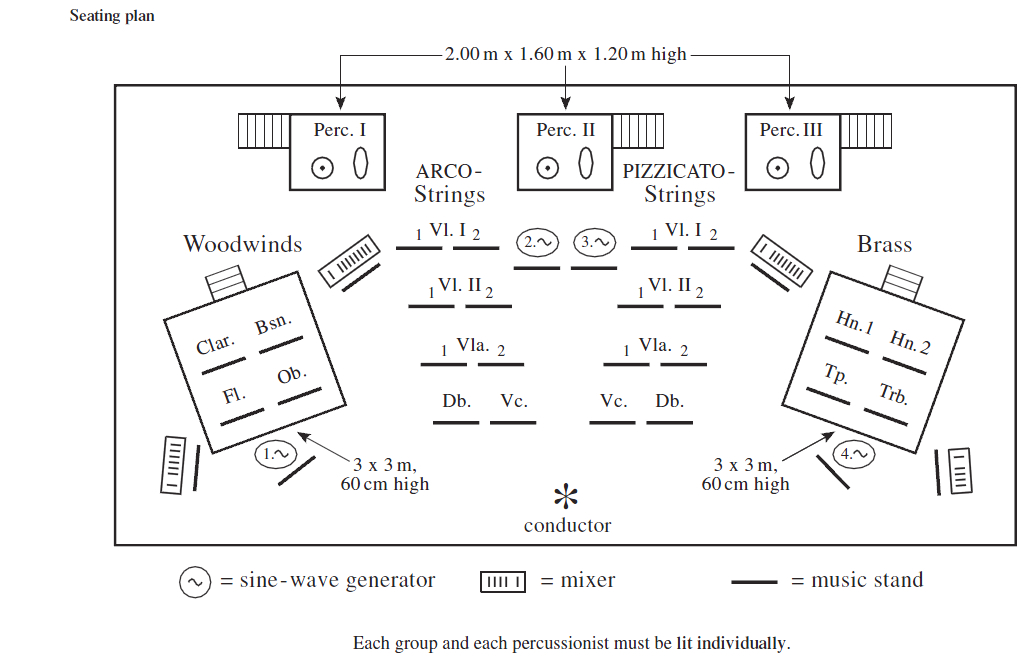
Seating plan
Each group and each percussionist must be lit individually.
Equipment for MIXTUR 2003
Sound equipment for tutti rehearsals and performance
24 microphones (6 H, 7 S, 7 P, 4 B);
2 contact microphones for 2 double basses;
6 contact microphones for percussion;
4 mixers on the stage (one with 4→4, one with 6→4,
two with 8→4);
1 mixing console in the hall (14 inputs, 9 outputs), with 8 VCA faders;
5 sine-wave generators (10 000–32 Hz / 32– 0.2 Hz, with one switch, or
none):  plus a fifth one for rehearsals;
plus a fifth one for rehearsals;
4 ring modulators;
4 earphones for the sine-wave generator players.
7 loudpeakers are suspended high above the stage: four of them about
6 m high above the orchestra groups H – S – P – B, and between them,
slightly to the rear and lower (ca. 4 m high), three for the 3 percussionists.
4 monitor loudspeakers for the 4 sound mixers stand on the stage.
2 x 2 loudspeakers stand or are suspended about 4.5 high in the rear of the
hall at the left and right. These loudspeakers are for the softer projection of
the 4 ring-modulated orchestra groups (not the percussion instruments)
distributed stereophonically from the left to right, to create a surrounding
spatial sound with clear orientation toward the front.
Sound equipment for 2 rehearsal rooms
During the first 4 days of rehearsals, rehearsals take place in 2 rooms
simultaneously (see Rehearsals on page XVI).
In the larger room A, 8 ARCO or 8 PIZZICATO strings rehearse in alternation,
each group with its sine-wave generator player and sound mixer.
Also the 3 PERCUSSIONISTS rehearse in this room A (see Set-up in
2 rehearsal rooms on p. XVI).
In room B, the winds rehearse: 4 WOODWINDS or 4 BRASS in alternation,
each group with its sine-wave generator player and sound mixer (see p. XII)
The 4 sine-wave generator players also rehearse in this room B (see Set-up in
2 rehearsal rooms on p. XVI).
For the sectional rehearsals the following equipment is necessary:
| in room A | 2 x 7 microphones, so that the positions for the ARCO strings and PIZZICATO strings do not have to be changed between rehearsals; 2 contact microphones for the 2 double basses; 6 contact microphones (3 x 2) for the 3 percussionists; 2 sine-wave generators; 2 earphones for the sine-wave generator players; 2 mixers having 8 inputs each for the sound mixers with 2 ring modulators; 2 monitor loudspeakers for the sound mixers; 1 mixer for the outputs of the 2 ring modulators, 2 mixers, 6 inputs of the 6 percussion contact microphones; 2 x 2 loudspeakers on stands at the left and right for hearing the total sound. For sectional rehearsals of the 4 sine-wave generators with the ring modulators, the equipment is moved from room A to room B: see Rehearsals on page XVI. |
| in room B | 6 und 4 microphones for the woodwinds and brass respectively, so that the positions do not have to be changed even if the groups alternate; 2 sine-wave generators; 2 earphones for the sine-wave generator players; 2 small mixers for the sound mixers with 2 ring modulators; 2 monitor loudspeakers for the sound mixers; 1 mixer for the outputs of the 2 ring modulators, 2 mixers;
2 x 2 loudspeakers on stands at the left and right for monitoringthe total sound |
For both rehearsal rooms the following personnel is necessary:
2 sound technicians (who are responsible for both rooms),
1 sound projecionist.
For the rehearsals of the 4 sine-wave generator players, either a 5th sinewave generator (eg. with a constant 880 Hz) is circuited to the 4 second inputs of the ring modulators instead of the microphones, and their outputs are circuited to the loudspeakers,
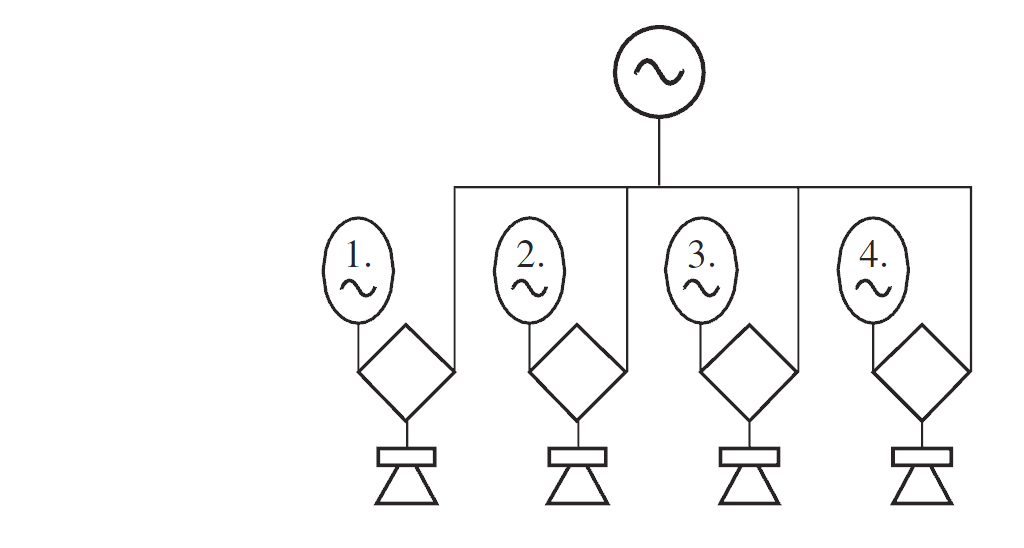
or the 4 sine-wave generators unmodulated are heard directly over 4 monitor loudspeakers, the volumes of which can be controlled by the players themselves.
Each of the 4 sine-wave generator players must be able to hear his sinetones over earphones.
The 4 small stage mixers must have Vu-Meters or better volume indicators.
If high quality equipment is used, then limiters are recommended.
In addition to the sound projectionist, the 4 sine-wave generator players, and the 4 sound mixers, also 2 sound technicians should participate: one for regularly testing the sine-wave generators and mixers, and the other one for setting up, adjusting and checking all the microphones. Therefore, all sectional rehearsals are to take place with sound equipment in the separate rooms, and the equipment should remain unchanged from rehearsal to rehearsal.
For the evening rehearsals with all 4 sine-wave generators and 4 small mixers, those from room A have to be moved to room B. Room B, where the small groups rehearse, must be large enough so that the loudspeakers can be set up far enough from the instruments.
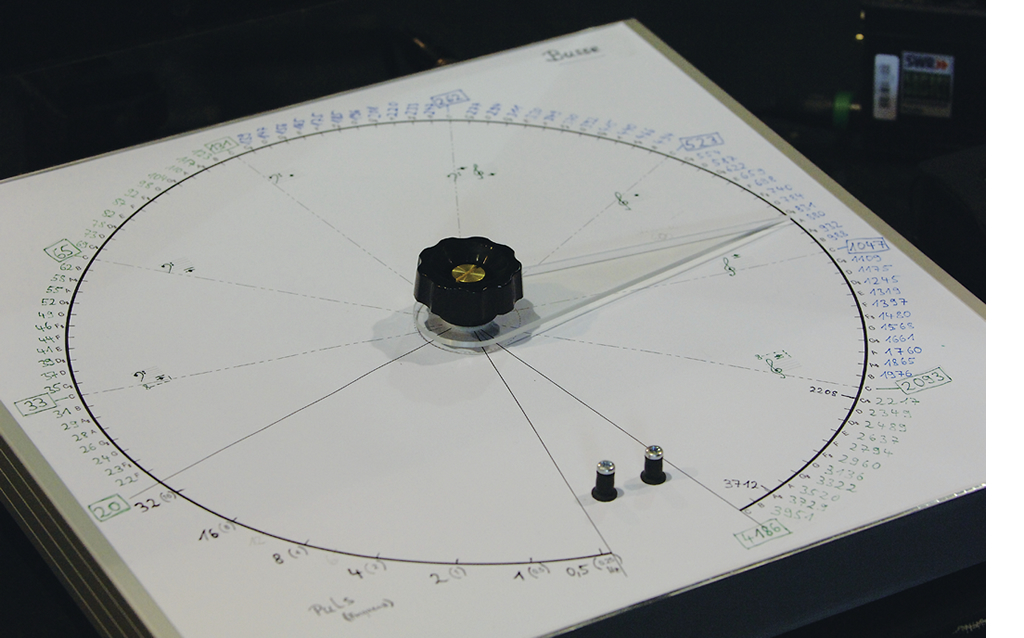
This device for controlling a sine-wave generator was specially designed by the Experimental Studio for Acoustical Art in Freiburg: The player’s entries may be seen on the calibrated paper circle which encompasses the 12-octave frequency range. A plexiglas arrow extending from the middle of the disc can be turned manually using the knob in the middle.
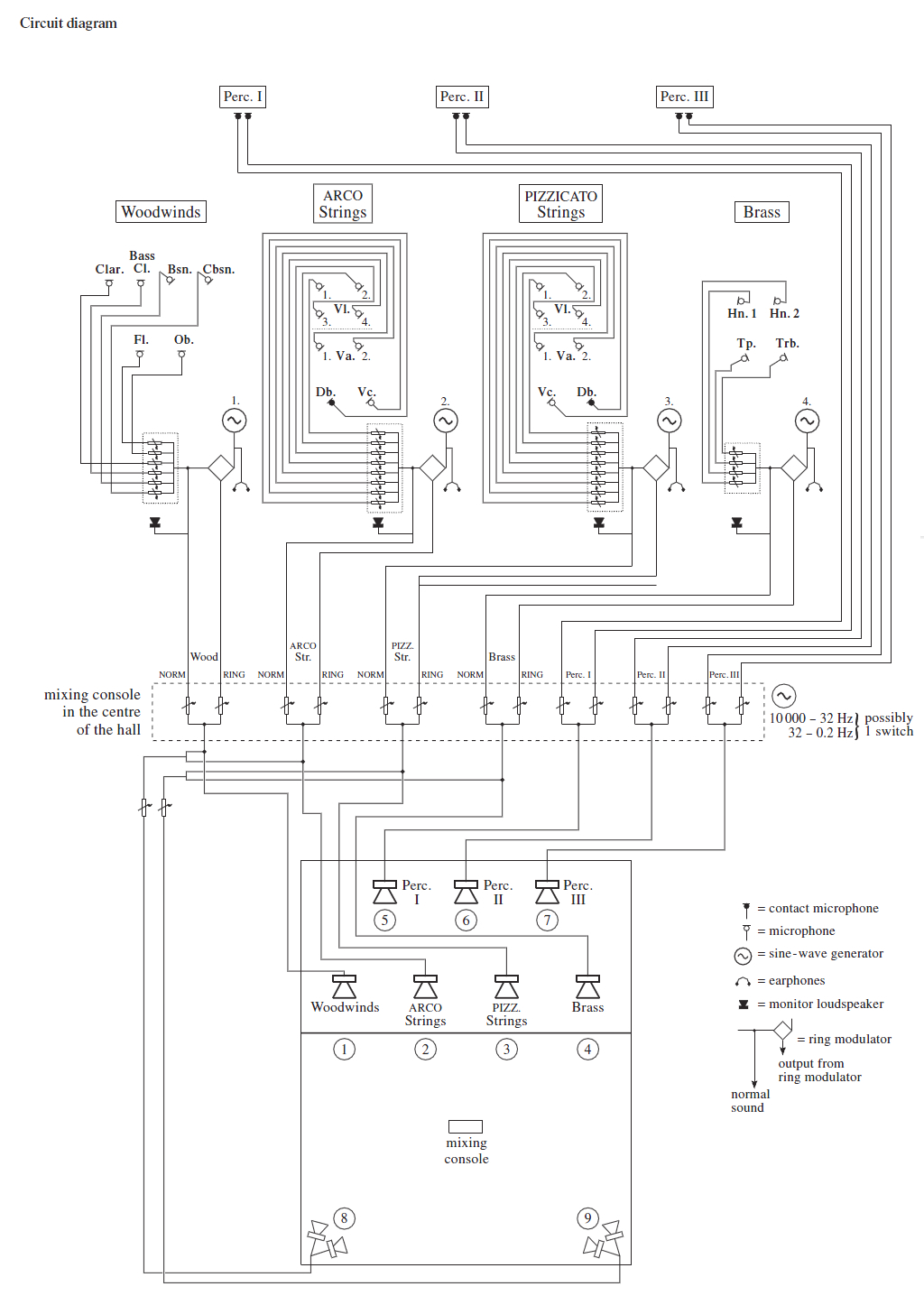
Rehearsals
The rehearsals of the 6 groups WOOD - ARCO - PIZZICATO - BRASS - PERCUSSION - 4 SINE-WAVE generators with ring modulators and sound mixers on 4 days necessitates having a conducting assistant in order to rehearse in 2 rooms simultaneously: Room A for 2 x 10 plus 3 players (ARCO and PIZZICATO strings in alternation, each with one sine-wave generator player and one sound mixer; 3 percussionists; conductor; 4 loudspeakers); Room B for 2 x 6 players (WOOD and BRASS in alternation, each with one sine-wave generator player and one sound mixer; assistant conductor; 4 loudspeakers).
Rehearsals for the world première with the Deutsche Symphonie-Orchester Berlin from August 21st–25th 2006 in Berlin and from August 26th–30th in Salzburg:
| 1st day | Set-up in 2 rehearsal rooms. | |||||||||
| Conductor in room A (larger room): | Conductor's assistant in room B: | |||||||||
| 2nd day | 10.00–13.00 ARCO strings |15.30–18.30 PIZZ. strings |19.00–20.30 PERC. || 10.00–13.00 WOOD |15.30–18.30 BRASS |19.00–20.30 SINE | |||||||||
| 3rd day | The same. | |||||||||
| 4th day | The same, but conductor and assistant conductor exchange rooms: assistant with ARCO, PIZZ. and PERC. in room A, conductor with WOOD, BRASS and SINE in room B. | |||||||||
| 5th day | The same as the 4th day. | |||||||||
| 6th day | Set-up of the sound equipment in the concert hall. | 1 more day of rehearsals is recommended for the strings. | ||||||||
| 7th day | 10.00–13.00 technical tests / 16.00–19.00 tutti rehearsal. | |||||||||
| 8th day | 10.00–13.00 / 16.00–19.00 tutti rehearsals. | |||||||||
| 9th day | 10.00–13.00 / 16.00–19.00 tutti rehearsals. | |||||||||
| 10th day | Dress rehearsal 10.00–13.00 and performance in the evening. | |||||||||
Set-up in 2 rehearsal rooms
For the rehearsals of MIXTUR 2003, the following must be prepared:
1. In ROOM A, set up at the half-left (as seen by the conductor):
8 chairs and 8 music stands for the ARCO strings (1 stool for the
double bass),
2 chairs, 2 tables and 2 music stands for the sine-wave generator player
and sound mixer,
1 music stand and 1 stool for the conductor,
At the half-right in ROOM A:
8 chairs and 8 music stands for the PIZZICATO strings (1 stool for the
double bass),
2 chairs, 2 tables and 2 music stands for the sine-wave generator players
and sound mixers.
On the stage at the left, middle and right in ROOM A:
3 music stands and 3 chairs for the percussionists,
low, middle and high-pitched tam-tams and 3 cymbals, with 3 tables for
the percussion instruments.
In Berlin (2006) the hall mixing console was set up in this room A and the sound projectionist took part in all rehearsals.
2. In ROOM B, the following should be set up at the half-left:
4 chairs and 4 music stands for the woodwinds,
2 chairs, 2 tables, and 2 music stands for the sine-wave generator players
and sound mixers,
1 music stand and 1 stool for the conductor.
At the half-right in ROOM B:
4 chairs, 4 music stands and 4 mute stands for the brass players,
2 chairs, 2 tables and 2 music stands for the sine-wave generator players
and sound mixers.
These set-ups remain for all the sectional rehearsals.
It is recommended that both the conductor and assistant conductor use a small portable keyboard to check the pitches of the sine-waves.
Programme
MIXTUR 2003 should be performed in two versions:
MIXTUR 2003 Forward Version (ca. 30')
– intermission –
MIXTUR 2003 Backward Version (ca. 30')
Thus, the sound equipment can remain in place (microphones, podia, music
stands, small mixers, sine-wave generators, loudspeakers, mixing console in
the hall).
There are two scores for the two versions (bound together) and different
sets of parts (also bound together).
If the two versions of MIXTUR are performed in the same concert, it
would be possible – directly following the intermission – to have a spoken
introduction or to project a 4-track work before performing the Backward
Version, for instance the electronic music GESANG DER JÜNGLINGE
(ca. 13½ Min.).
Beauty of mirrored overtone harmonies
The essential aspect of MIXTUR is, on one hand, the transformation of the
familiar orchestra sound into a new, enchanting world of sound. It is an
unbelievable experience, for example, to see and hear string players bowing a
sustained tone and to simultaneously perceive how this tone slowly moves
away from itself in a glissando, the pulse accelerates, and a wonderful
timbre spectrum emerges. Orchestra musicians are astonished when they
hear the notes they play being modulated timbrally, melodically, rhythmically,
and dynamically. All shades of the transitions from tone to noise,
noise to chord, from timbre to rhythm and rhythm to pitch come into being
from such ring modulations, as if by themselves.
Finest micro-intervals, extreme glissandi and register changes, percussive
attacks resulting from normally smooth entrances, complex harmonies
(also above single instrumental tones), and many other unheard-of sound
events result from this modulation technique and from the variable structuring.
Secondly, the ring modulation adds new overtone- and sub-tone series to
the instrumental spectra, which can be clearly heard, especially during
sustained sounds in MIXTUR. Such mixtures do not occur in nature or with
traditional instruments. Through these mirrored overtone harmonies, one is
moved by alien, haunting sensations of beauty, which are completely new in
art music.
Only such renewal in how music affects us imbues new techniques with
meaning.
MIXTUR was the genesis of live electronic music which, in the four decades since its birth, has already developed multifariously, as witnessed by many parts of my work, LICHT.
Notation
1 = moment 1 of 20 moments.
3.1 = Page 1 of moment 3.
SCH = 3 percussionists:
I  = relatively low-pitched cymbal,
= relatively low-pitched cymbal,
 = 1 relatively low-pitched tam-tam.
= 1 relatively low-pitched tam-tam.
II  = middle- to high-pitched cymbal,
= middle- to high-pitched cymbal,
 = middle- to high-pitched tam-tam,
= middle- to high-pitched tam-tam,
III  = relatively high-pitched cymbal,
= relatively high-pitched cymbal,
 = relatively high-pitched tam-tam.
= relatively high-pitched tam-tam.
Each percussionist is seated with quite a large cymbal  in front of him
(her) and a tam-tam
in front of him
(her) and a tam-tam  (ca. 60–80 cm Ø) at his left; the cymbal is on a
stand so that it is seen from above; the tam-tam is hung in such a way that it
is possible to scratch, rub, and scrape its surface (usually the edge of the
back) while seated. A small table with the utensils with which the cymbal
and tam-tam are played is in front of him, next to the music stand.
(ca. 60–80 cm Ø) at his left; the cymbal is on a
stand so that it is seen from above; the tam-tam is hung in such a way that it
is possible to scratch, rub, and scrape its surface (usually the edge of the
back) while seated. A small table with the utensils with which the cymbal
and tam-tam are played is in front of him, next to the music stand.
The tam-tams should have a rough surface, not a smooth one like PAISTE tam-tams usually have, so that a tone is produced by rubbing it (for example by exerting pressure on the end of a drumstick).
The rack for the music is above the cymbal. The chairs must be high enough so that it is possible to easily see the conductor over the music.
For the rehearsals and performance, each of the 3 x 2 instruments are amplified using contact microphones.
A special rehearsal room should be reserved for the percussionists, where they can rehearse by themselves during the day. It should not be too far away from room A so that their instruments, music stands and chairs can be moved there.
The instruments are seldom struck in the normal way. The percussion technique of MIXTUR originated in my works KONTAKTE, MIKROPHONIE I, MOMENTE, etc. Therefore, each player must prepare and experiment with a selection of small tin cans with sharp edges, plastic and cardboard boxes with hard edges, and relatively narrow cardboard tubes.
For some places iron clappers (as in cowbells) are needed, for instance percussionist 3, bar 8 Knall (bang).
For some beats, a stick may also be used.
Where Schlag (beat) is indicated, one of the utensils (for instance a metal can, as in bar 62) is used for beating.
In the solo of the 3 percussionists (bars 8 to 16) and at other places (for instance 116 to 122 etc.) the desired timbre is described using words such as : Schrei (shriek) - Knall (bang) - kreisch (screech) - heulen (howl) - quietschen (squeak) - kratzen (scratch), or with phonetic syllables such as [kεη] - [brra∫] - [hu–ram] - [tuη–ua] - [kax] - [pւη] - [tεη] - [kri–x] - [puη] - [ka–i].
For the tam-tams, soft, heavy beaters are needed for the slow rolls (soft, thick timpani beaters?), for example starting at bar 158.
The word Ruck (jerk) often occurs. To do this, the edge of a metal or plastic box is pressed against the cymbal or tam-tam and is very briefly jerked, through which the instrument is suddenly set into vibration and resonates.
The three percussionists seemingly "do not have much to do". But it would be good if they would develop their timbre art to such an extent that their sounds would mix well with the ring modulated sounds of the orchestra.
In any case, there is much to be discovered and invented.
H = WOODWINDS,
H∿= sine-wave generator for H.
Fl = flute (also piccolo).
Ob = oboe.
Kl = clarinet (also E-flat clarinet and Bkl = bass clarinet).
Fg = bassoon (also Kfg = contrabassoon).
S = STRINGS, who usually play ARCO.
S∿ = sine-wave generator for ARCO Strings.
Vl = violins (1–4).
Va = violas (1–2).
Vc = violoncello.
Kb = double bass.
P = PIZZICATO strings, who occasionally also play arco.
P∿ = sine-wave generator for P.
Vl = violins (1–4).
Va = violas (1–2).
Vc = violoncello.
Kb = double bass.
B = BRASS,
B∿ = sine-wave generator for B.
Tp = trumpet.
Hn 1 = horn 1 (high).
Hn 2 = horn 2 (low).
Pos = trombone.
Horns:  = open;
= open;
 = stopped;
= stopped;
 = quasi closed,
= quasi closed,
 = quickly close (from open);
= quickly close (from open);
 = quickly open (from closed), occasionally also long
= quickly open (from closed), occasionally also long
transitions (e.g. bars 206 / 207 or 214).
Dämpfer (mute) = insert mute, = remove mute.
= remove mute.
Trumpet and trombone:
W = wawa mute:  = open, =
= open, =  nearly closed,
nearly closed,
 = gradually close,
= gradually close,
 = gradually open.
= gradually open.
Spitz = straight mute.
C = cup mute.
Dpf. = mute.
 = remove mute.
= remove mute.
Flzg. = flutter-tongue.
norm. = normal.
pont. = sul ponticello (at the bridge).
tasto = sul tasto.
legno = col legno tratto (with wood and hair).
batt. = col legno battuto, but clear pitch.
(See the signs for special ways of playing in 131 to 13.7 etc.)